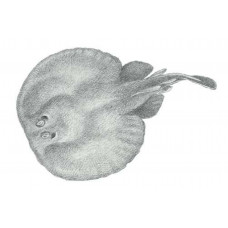Latin name
Torpedo nobiliana
Other names
Torpedo, electric ray, dark electric ray; French: torpille noire; Spanish: tremolina negra.
Identification
Atlantic torpedo has a broad disc, flattened in front, and a short snout. It has a uniform dark olive to brown or black color, sometimes with black spots and small white spots, and is whitish underneath. The Atlantic torpedo can be distinguished from its relatives by its large size. The Atlantic torpedo can generate an electric shock of between 170 and 220 volts. The organs that generate electricity are located in the front half of the body, one on each side, making up about one-sixth of the fish's total weight. It can use them to stun its prey, protect it from predators, and identify or attract members of the opposite sex.
Distribution
This species lives strictly in the Atlantic Ocean, from Nova Scotia and the Bay of Fundy to the Florida Keys and Cuba, absent in the Gulf of Mexico.
Habitat
Atlantic torpedoes live on sand or gravel bottoms, more often found in the colder parts of their range. They are thought to be most common in waters between 60 and 240 feet deep.
Size
The average fish weighs about 30 pounds, with known cases that have reached 200 pounds and a length of 6 feet.
Life history and Behavior
Breeding takes place at greater depths in warmer areas, and the young are born alive.
Food and feeding habits
Atlantic torpedoes are slow-bottom dwellers and feed on fish such as flounder and eel, although they are capable of capturing fast-swimming prey such as sharks and salmon.
Reproduction
No information
| Classification | |
| Phylum | Chordata |
| Class | Chondrichthyes |
| Squad | Torpediniformes |
| Family | Torpedinidae |
| Genus | Tetronarce |
| Species | T. nobiliana |
| Features | |
| Conservation status | Least Concern |
| Habitat | Bottom |
| Life span, years | No information |
| Maximum body weight, kg | 90 |
| Maximum length, cm | 1.8 |
| Sailing speed, m/s | No information |
| Threat to people | No information |
| Way of eating | Predator |

